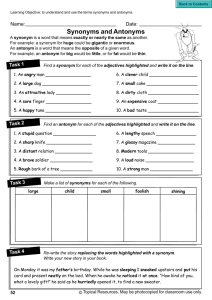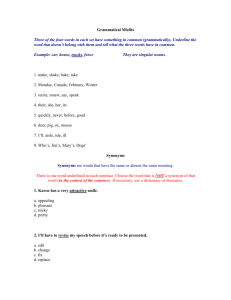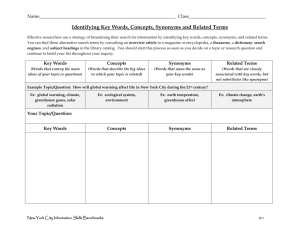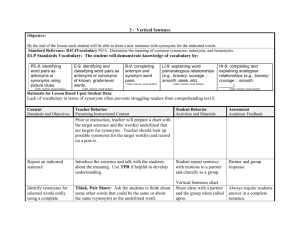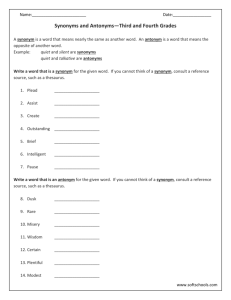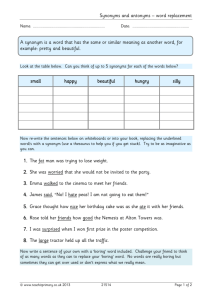STRATEGY-Synonym Triplets
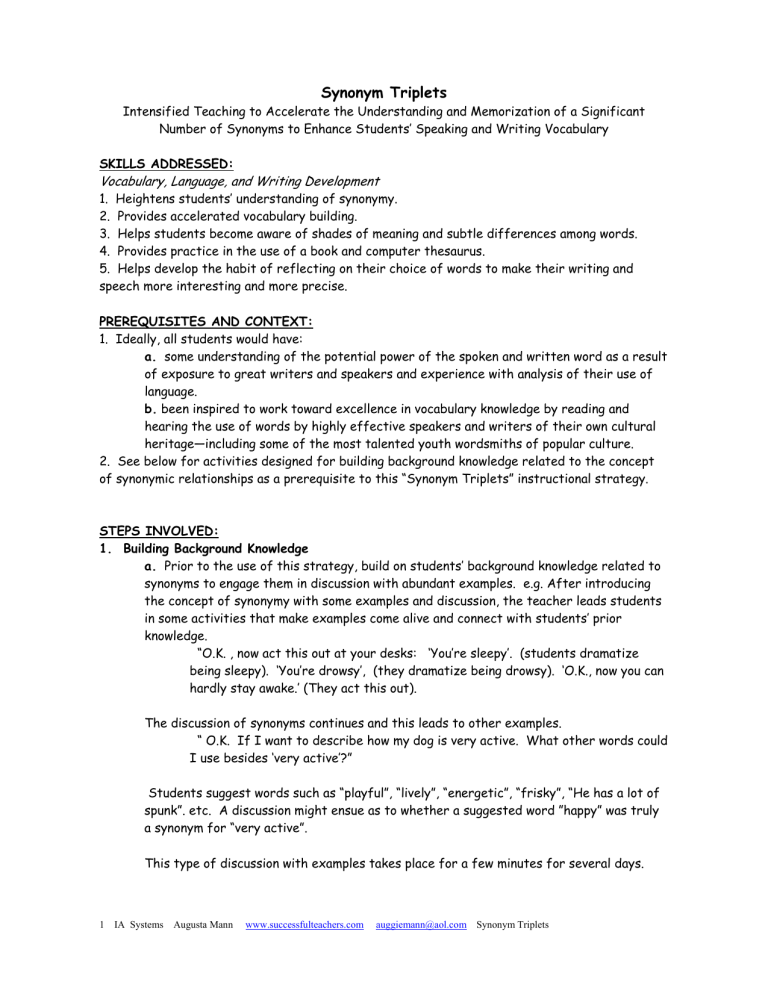
Synonym Triplets
Intensified Teaching to Accelerate the Understanding and Memorization of a Significant
Number of Synonyms to Enhance Students’ Speaking and Writing Vocabulary
SKILLS ADDRESSED:
Vocabulary, Language, and Writing Development
1. Heightens students’ understanding of synonymy.
2. Provides accelerated vocabulary building.
3. Helps students become aware of shades of meaning and subtle differences among words.
4. Provides practice in the use of a book and computer thesaurus.
5. Helps develop the habit of reflecting on their choice of words to make their writing and speech more interesting and more precise.
PREREQUISITES AND CONTEXT:
1. Ideally, all students would have: a.
some understanding of the potential power of the spoken and written word as a result of exposure to great writers and speakers and experience with analysis of their use of language. b.
been inspired to work toward excellence in vocabulary knowledge by reading and hearing the use of words by highly effective speakers and writers of their own cultural heritage—including some of the most talented youth wordsmiths of popular culture.
2. See below for activities designed for building background knowledge related to the concept of synonymic relationships as a prerequisite to this “Synonym Triplets” instructional strategy.
STEPS INVOLVED:
1. Building Background Knowledge a.
Prior to the use of this strategy, build on students’ background knowledge related to synonyms to engage them in discussion with abundant examples. e.g. After introducing the concept of synonymy with some examples and discussion, the teacher leads students in some activities that make examples come alive and connect with students’ prior knowledge.
“O.K. , now act this out at your desks: ‘You’re sleepy’. (students dramatize being sleepy). ‘You’re drowsy’, (they dramatize being drowsy). ‘O.K., now you can hardly stay awake.’ (They act this out).
The discussion of synonyms continues and this leads to other examples.
“ O.K. If I want to describe how my dog is very active. What other words could
I use besides ‘very active’?”
Students suggest words such as “playful”, “lively”, “energetic”, “frisky”, “He has a lot of spunk”. etc. A discussion might ensue as to whether a suggested word ”happy” was truly a synonym for “very active”.
This type of discussion with examples takes place for a few minutes for several days.
1 IA Systems Augusta Mann www.successfulteachers.com
auggiemann@aol.com
Synonym Triplets
b.
After students understand the concept, lead them in an oral recitation of an explanatory statement for several days until the recitation is memorized.
For example:
“A synonym is a word that means the same or almost the same as another word. The words postpone, delay, and procrastinate are synonyms. Synonyms are important for us to learn because they help us find ju-u-u-st the right word when we are expressing our thoughts in our speech or in our writing.
A thesaurus is a reference tool for identifying synonyms. We can look up synonyms in a thesaurus in book form and we can find synonyms using the thesaurus on our computers. Our goal is to study and become expert synonymists!”
2. Identifying Words
Identify words from trade books and classroom texts whose meanings students need to master.
Choose words that are appropriate for the study of synonyms and ones that you would want students to use in their speech and writing. For two of the words in each triplet, select grade level and above grade level words. Don’t limit the list to words that students already know or can already read . We want to quickly expand students’ oral as well as written and reading vocabulary.
(Can’t underperforming kindergarteners for example, whose learning we want to accelerate learn and understand the synonyms: “help, aid, assist” or “important, significant, valuable” and use them in their speech just as many kindergarten children of college educated parents do-- coming to school having heard these synonyms many times over the years? We aren’t necessarily teaching them to read or write these words at this time.)
3. Deciding on the Synonyms
Write two synonyms for each of the words, arranging them in an order that lends itself to memorable rhythmic recitation. One of the words should be a word familiar to most students.
This word anchors the discussion of the meanings of all three words. See examples below.
(As a resource, The Reading Teachers Book of Lists has 3 pages of synonym in groups of three)
4. Creating a Chart
Create a chart of eight sets of synonym triplets . Leave a small space (about 2”) for a picture to the left of each word. Arrange the words in an order that lends itself to memorable rhythmic recitation.
5. Choosing Definitions and Sentences
Quickly look up a short definition and explanatory sentence for each synonym. It took only two minutes to pull up these three definitions from a computer thesaurus. I tried to think of sentences that would help students form a mental picture and aid in learning and remembering.
Calm means a situation of complete peace and quiet, with no noise, trouble, or anxiety.
Our classroom was so-o-o calm during “Drop Everything And Read” time. ( or “DEAR” time)
Serene means calm and not troubled by worry, stress or disturbance.
This picture shows a man who is very sere-e-e-n.
Peaceful means quiet and calm—serene and untroubled in the mind.
I had a very peaceful rest lying on the deserted beach.
2 IA Systems Augusta Mann www.successfulteachers.com
auggiemann@aol.com
Synonym Triplets
6. Using the Definitions and Sentences
Use these definitions and sentences as references when teaching and discussing the shades of meaning for each of the words. Students are not asked to memorize these at this time.
See # 11 and #12 below for more on the use of the definitions and sentences.
7. Covering Up
Using very large sticky notes, (6”-8” x8”) cover all triplets except the first one.
8. Day 1--Discussing and Demonstrating—The First Triplet (7-10 min.)
Using the definitions and sentences as aids for understanding, lead students in a discussion and demonstration of each of the words in the first triplet so that students not only understand all the meanings, but can relate them to their lives and experiences. At the end of the lesson, provide pre-cut art paper pieces small enough to fit on the chart to the left of each triplet.
Ask one or two students to illustrate the meaning of the words in the triplet for the chart.
9. Day 2--Discussing and Demonstrating—The First and Second Triplets (7-10 min.)
The next day review the first triplet and uncover the second set of triplets and again using the definitions and sentences as aids for understanding, lead students in a discussion and demonstration until everyone understands. Students illustrate these words.
10. Day 3--Discussing and Demonstrating--The First Three Sets of Triplets (7-10 min.)
On the 3 rd . day repeat the process of review of the first two triplets and introduction and discussion of the third set of triplets. Again students create small drawings.
11. Day 4--Beginning the Rhythmic Recitation (5 min.)
On the 4 th day after a quick review of the meaning of the words in the three triplets, begin the rhythmic recitation and memorization of all three triplets. e.g. “hard, dif—fi—cult, cha—len—ging”---- “hard, dif—fi—cult, cha—len—ging”----“
“calm, se-rene, pea-e-e-ce-ful” ---- “calm, se-rene, pea-e-e-ce-ful”---
“di-vide, se—per—ate, split—it—up” --- “di-vide, se—per—ate, split—it—up”
12. Day 5--Continue the Rhythmic Recitation--Student Leadership (5 min)
On the 5 th day with one of the students leading it, continue this recitation. (5 min.)
13. Day 6--Reviewing All Nine Sentences Using Call and Response Pattern--(7 min.)
On the 6 th day have the nine sentences for the three triplets written on the board, chart, or transparency. Review all nine sentences that were discussed when the triplets were first introduced. Divide the class in half—each side of the room is one team. Then using a call and response pattern Team #1 shouts out the first word of the first triplet e.g. “calm!”. Team #2 responds by reciting in unison (with gusto) the sentence: “Our class is very calm during DEAR time.”
Then it is Team #2 ‘s time to shout out the second word of the first triplet e.g. “serene!” and
Team #1 recites in unison (with gusto) the sentence: “This picture shows a man who is very sere-e-ene.” This process is repeated for the third word of the first triplet. The students complete this first part with the rhythmic recitation of the first triplet. “Calm, se---rene, pea—e-e-ce-ful” . They then continue in this manner with the other two triplets.
3 IA Systems Augusta Mann www.successfulteachers.com
auggiemann@aol.com
Synonym Triplets
14. Days 7-18--Review and Repeat the Process with Each of the Next set of Three
Triplets---The Seventh –Eighteenth Day
Quickly review the first three triplets and then go on to the first of the next set of three triplets and repeat the process of teaching, practice, recitation, and memorization. Over the course of approximately one month or less, with these short lessons 4-5 days a week, students should have mastered the meanings of all eight synonym triplets on the chart and be using them in their speech and/or writing and recognizing them in their textbooks and trade books.
Students can take more and more of the leadership of the recitation, illustration, and creating of the sentences as the active study and mastery of synonyms becomes the classroom norm.
15. A Week of Review of Chart #1 and Beginning the Process with a Second Chart of
Eight Triplets
After a week of teacher and student-led review of the first chart of eight triplets, begin the process with a second chart. As the lessons proceed through the year, the teachers habitually flips back to previous charts for brief reviews.
16. School Year Goals and the Power of Group Commitment
The goal is the mastery by all students of the synonyms on 4-5 charts (or more) for the school year. That means understanding the meanings of the words and having the ability to use them correctly in sentences. When teachers in a school involve themselves as a group in setting and meeting these types of goals with this strategy and the other IA strategies for vocabulary building, students go from one grade to the next with enhanced vocabulary skills that strongly impact all their literacy skills.
RELATED LEARNING PRINCIPLES:
1. The use of rhythm, recitation, and repetition as cultural principles to gain students’ attention, aid memory, and reveal patterns in language.
2 The brain continually seeks patterns.
3. Utilizing research in culture and cognition in the acceleration of learning.
APPLICATION AND EXTENSIONS:
1. Depending on the age of the students, the use of a book and computer thesaurus should definitely be included in the extension activities.
2. Students continually identify appropriate words in their texts and create synonym triplets.
3.
Students continually add to the charted class lists and learn to lead lessons on mastery of these. Students are required to use these words in their speech and writing.
4. Students prepare large index cards for independent study of the synonym triplets introduced. On one side of a card the triplet is written. On the other side only one of the three words is written. Students quiz each other holding a card with only one word showing. Their partner has to say the other two words that make up the triplet studied.
5. Students create drawings –one on a card. On the back side of the card is a synonym triplet.
Partners have to guess the triplet after viewing the picture.
6. Students can create additional activities to use in independent work study of synonyms.
4 IA Systems Augusta Mann www.successfulteachers.com
auggiemann@aol.com
Synonym Triplets
